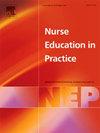Self-efficacy in clinical performance scale: A psychometric validity study with nursing students
IF 3.3
3区 医学
Q1 NURSING
引用次数: 0
Abstract
Aim
To translate the Self-Efficacy in Clinical Performance scale into Brazilian Portuguese and evaluate its psychometric properties.
Background
Self-efficacy is key to academic performance, supporting the growth of clinical and personal skills. Promoting self-efficacy in nursing students requires educational strategies that enhance both confidence and competence, along with effective tools to measure and deepen understanding of self-efficacy.
Design
This research used a cross-sectional study design, collecting data from undergraduate nursing students at public and private universities in Brazil during 2022 and 2023. Data from 375 students with clinical practice experience were used for psychometric testing. Of these participants, 45 completed a test-retest.
Methods
The Self-Efficacy in Clinical Performance scale was translated and evaluated in six steps: forward translation, forward translation synthesis, backward translation, backward translation synthesis, cognitive debriefing and psychometric testing. The psychometric properties of the translated instrument were investigated using confirmatory factor analysis, Cronbach’s alpha, McDonald’s omega, composite reliability and test-retest analyses.
Results
The translated instrument proved acceptable. In the confirmatory factor analysis, fit indices demonstrated an excellent model fit. The Cronbach’s alpha, McDonald’s omega and composite reliability values at the latent factor levels ranged from .93 to.98, indicating good internal consistency. Test-retest analyses indicated good to excellent test-retest reliability in all the latent factors, with intraclass correlation coefficients ranging from 0.852 to 0.924.
Conclusions
The Brazilian Portuguese version of the Self-Efficacy in Clinical Performance scale offers potential as a useful instrument to assess the self-efficacy of nursing students in clinical practice in nursing education.
临床表现量表中的自我效能感:护生心理效度研究
目的将临床表现自我效能量表翻译成巴西葡萄牙语,并评价其心理测量特性。自我效能感是学习成绩的关键,支持临床和个人技能的发展。提高护理学生的自我效能感需要提高自信和能力的教育策略,以及有效的工具来测量和加深对自我效能感的理解。本研究采用横断面研究设计,收集了2022年至2023年巴西公立和私立大学护理专业本科生的数据。采用375名具有临床实践经验的学生的数据进行心理测试。在这些参与者中,有45人完成了重新测试。方法采用正向翻译、正向翻译综合、后向翻译、后向翻译综合、认知述职和心理测试6个步骤对临床表现自我效能感量表进行翻译和评价。采用验证性因子分析、Cronbach’s alpha、McDonald’s omega、复合信度和重测分析对翻译仪器的心理测量特性进行了研究。结果翻译后的仪器可接受。在验证性因子分析中,拟合指标显示了良好的模型拟合。潜在因素水平上的Cronbach 's alpha, McDonald 's omega和复合信度值范围为0.93 ~。98分,表明内部一致性好。重测分析表明,各潜在因素的重测信度均为良好至极好,类内相关系数为0.852 ~ 0.924。结论巴西葡萄牙语版临床表现自我效能感量表可作为评估护生临床实践自我效能感的有效工具。
本文章由计算机程序翻译,如有差异,请以英文原文为准。
求助全文
约1分钟内获得全文
求助全文
来源期刊

Nurse Education in Practice
NURSING-
CiteScore
5.40
自引率
9.40%
发文量
180
审稿时长
51 days
期刊介绍:
Nurse Education in Practice enables lecturers and practitioners to both share and disseminate evidence that demonstrates the actual practice of education as it is experienced in the realities of their respective work environments. It is supportive of new authors and will be at the forefront in publishing individual and collaborative papers that demonstrate the link between education and practice.
 求助内容:
求助内容: 应助结果提醒方式:
应助结果提醒方式:


